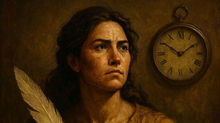The Orientalist Painter Gustav Bauernfeind - 120th Death Anniversary
- Web Portal Eastern Pearl

- Aug 9, 2024
- 3 min read
This year marks 120th anniversary of death of the orientalist painter Gustav Bauernfeind

Gustav Bauernfeind
Gustav Bauernfeind, born on September 4, 1848, in Sulz am Neckar, Germany, remains a pivotal figure in the world of Orientalist painting, even 120 years after his death. As we commemorate this anniversary, it's essential to reflect on the life and work of an artist who, despite his initial fading into obscurity, has posthumously reclaimed his place as one of Germany's most remarkable painters of the 19th century.
Early Life and Architectural Beginnings
Bauernfeind was born into a family with Jewish roots; his father, a pharmacist, had converted to Catholicism. From an early age, Gustav showed an aptitude for the arts, which led him to study architecture at the Polytechnic Institute in Stuttgart. His education there paved the way for his initial career as an architect, working in the firm of Professor Wilhelm Bäumer and later under Adolph Gnauth, where he also honed his skills in painting. His early works primarily depicted local views of Germany and scenic motifs from Italy, reflecting his training as an architect and his burgeoning interest in capturing the world around him with precision.
A Journey to the Orient
In 1880, Bauernfeind embarked on a journey that would alter the course of his life and artistic career. His travels to the Levant from 1880 to 1882 ignited a profound interest in the Orient, a fascination that would dominate the remainder of his career. Captivated by the architecture and daily life of the Middle East, he returned repeatedly to the region, eventually moving with his wife and son to Ottoman Palestine in 1896. By 1898, the family had settled in Jerusalem, where Bauernfeind continued to live and work until his death in 1904. His time in the Middle East also included periods spent in Lebanon and Syria, where he produced some of his most iconic works.
Artistic Style and Contributions
Bauernfeind's art is characterized by his meticulous attention to architectural detail, an element that reveals his background in architecture. His oil paintings, many of which feature the cityscapes of Jerusalem and the Holy Land, are noted for their almost photographic accuracy and intricate compositions. Among his most famous works are “Die Klagemauer, Jerusalem” (The Wailing Wall, 1890) and “Der Hafen von Jaffa” (The Port of Jaffa, 1888), both of which are celebrated for their stunning detail and ability to capture the spirit of their locations.
In addition to cityscapes, Bauernfeind also painted landscape scenes and watercolors, further demonstrating his versatility and deep connection to the places he depicted. His works offer a unique glimpse into the architectural and cultural heritage of the Middle East during the late 19th century, making them invaluable records of the era.
Legacy and Rediscovery
Bauernfeind's life was tragically cut short by a heart defect, leading to his death from a heart attack in Jerusalem on December 24, 1904, at the age of 56. Despite his popularity during his lifetime, his work fell into obscurity after his death. It wasn't until the early 1980s that Bauernfeind's work began to be rediscovered and appreciated once again. The resurgence of interest in Orientalist art brought his paintings back into the spotlight, and they began to fetch high prices at auctions. Notably, his painting “The Wailing Wall” was sold at Christie's in London in 1992 for the equivalent of €326,000, and later at Sotheby's in 2007 for an astonishing €4.5 million.
In 1997, another of his works, “The Port of Jaffa,” was sold at the Van Ham Kunstauktionen in Cologne for 1,510,000 DM, setting a record as the most expensive 19th-century painting ever sold in Germany.
As we mark the 120th anniversary of Gustav Bauernfeind's death, we are reminded of the enduring power of his work and the remarkable journey of his legacy - from celebrated artist to forgotten figure, and back again to a place of honor in art history. His detailed and evocative portrayals of the Middle East continue to captivate audiences, offering a window into a world that, while geographically distant, is brought vividly to life through his artistry. In celebrating Bauernfeind's contributions, we acknowledge the timelessness of his vision and the lasting impact of his work on the art world.
Article: Ana S. Gad
Source/Photo: Wikipedia









































Comments